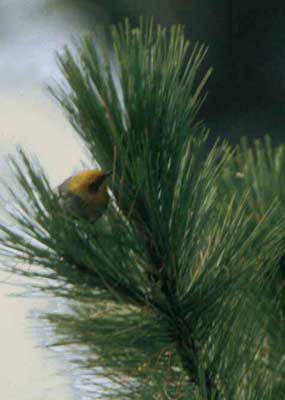 The
Olive
Warbler (left) is a small passerine that is primarily resident in pine-oak
forests of mountains from southeastern Arizona to Nicaragua. It acts like
a New World warbler — and is usually considered a New World warbler [Parulidae]
— but the DNA evidence shows it to be of a distinct lineage. The AOU also
points to differences in morphology and breeding biology (George 1962,
1968) in raising it to family status. What George (1968) found is that
it had a cylindrical (not compressed) bone in its hyoid apparatus — as
found in all Old World songbirds — which is not found in any other New
World nine-primaried passerines except the Swallow-Tanager
Tersina viridis.
It also had a nest more like a kinglet, and eggs unlike parulids (George
1962). For these reasons some thought it might actually be an Old World
warbler [Sylviidae]. The
Olive
Warbler (left) is a small passerine that is primarily resident in pine-oak
forests of mountains from southeastern Arizona to Nicaragua. It acts like
a New World warbler — and is usually considered a New World warbler [Parulidae]
— but the DNA evidence shows it to be of a distinct lineage. The AOU also
points to differences in morphology and breeding biology (George 1962,
1968) in raising it to family status. What George (1968) found is that
it had a cylindrical (not compressed) bone in its hyoid apparatus — as
found in all Old World songbirds — which is not found in any other New
World nine-primaried passerines except the Swallow-Tanager
Tersina viridis.
It also had a nest more like a kinglet, and eggs unlike parulids (George
1962). For these reasons some thought it might actually be an Old World
warbler [Sylviidae].
DNA-DNA hybridization (e.g., Sibley & Ahlquist 1990) suggested that
it was a sister group to fringillid finches — not a warbler at all. This
was so unexpected that Sibley & Monroe (1990) said that the "result
requires confirmation or contrary evidence." Additional biochemical work
tending to confirm this finding, and the most recent A.O.U. Check-list
(AOU 1998) considered the Peucedramidae as a family. The most recent genetic
evidence (e.g., Barker et al. 2002, 2004) as shown a closer relationship
with the Old World accentors [Prunellidae]. It now appears that the Olive
Warbler is a relict of a New World expansion of the accentors, left behind
after the last Ice Age, just as the Wrentit Chamaea fasciata is
a relict babbler, the only one in the New World. It is possible that in
the future the Olive Warbler will be merged with Accentors, but for now
both the A.O.U. and Dickinson (2003) consider it a separate family. I follow
suit here because I'm including all the Dickinson (2003) families.
|
| It is not hard to find an Olive Warbler, either in the mountains of southeast Arizona or the Mexican highlands, so it is easy to "bank" for one's world-bird-families quest. Although there is some downslope movement in response to weather, this species is apparently not significantly migratory. Although it occurs as close to California as southeastern Arizona, there has never been a California record. This contrasts strikingly with almost all other North American warblers, many of which occur annually as vagrants on migration. Indeed, only the short distance migrants Colima and Swainson's Warblers, and the endangered Kirtland's Warbler (nests in Michigan, winter in the Bahamas), have not yet made a California appearance. If it is actually an essentially resident accentor, or near-accentor relative, its absence from California makes better sense. |
| . |
| Photos: The Olive Warbler Peucedramus
taeniatus was on Volcan Popocatepetl, Mexico, on 30 Dec 1995.
Photo © D. Roberson, all rights reserved.
Bibliographic note There is no family book but this species is covered in standard American warbler texts. Literature cited:
Barker, F.K., G.F. Barrowclough, and J.G. Groth. 2002. A phylogenetic hypothesis for passerine birds: taxonomic and biogeopgraphic implications of an analysis of nuclear DNA sequence data. Proc. Roy. Soc. Lond. B. 269: 295-305
Dickinson, E.C., ed. 2003. The Howard & Moore Complete Checklist of the Birds of the World. 3d ed. Princeton Univ. Press, Princeton, N.J. George, W.G. 1962. The classification of the Olive Warbler, Peucedramus taeniatus. Amer. Mus. Novitates 2103. George, W.G. 1968. A second report on the basilyale in American songbirds, with remarks on the status of Peucedramus. Condor 70: 392-393. Sibley, C.G., and J.E. Ahlquist. 1990. Phylogeny and Classification of Birds: A Study in Molecular Evolution. Yale Univ. Press, New Haven, CT. Sibley, C.G., and B.L. Monroe. 1990. Distribution and Taxonomy of Birds of the World. Yale Univ. Press, New Haven, CT. |